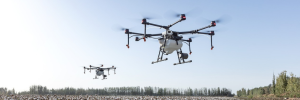
Research on collision avoidance can help boost the use of drones
Automation has led to an increase in the use of unmanned aerial vehicles (UAVs), commonly known as drones, in many fields, ranging from the film industry to agricultural applications to military operations. This boom has created new challenges for automation to overcome, such as the need for UAVs to fly in crowded airspaces and avoid colliding with each other.
To help address the deficiency in inter-UAV collision avoidance capabilities, Dr Lauren Meiring developed and evaluated cooperative collision avoidance algorithms for UAVs that are capable of avoiding short-term collisions with static and dynamic obstacles as well as collisions between UAVs while communicating their positions, velocities, and intended flight trajectories in complex environments. Meiring recently obtained her doctorate in Electronic Engineering at Stellenbosch University. The title of her thesis was Cooperative Collision Avoidance Strategies for Unmanned Aerial Vehicles.
“Currently, there is no commonly implemented collision avoidance system that prevents inter-UAV collisions. Some commercially available UAVs do implement collision avoidance, but only for static obstacles. When UAVs are equipped with inter-UAV collision avoidance, it is normally to achieve a specialised task and, as such, is not applicable to independent UAVs performing individual tasks," says Meiring.
She adds: “These UAVs are assumed to be following long-term routes, such as flying between warehouses. When a collision is predicted along these routes, all UAVs cooperate to plan and execute short-term collision avoidance trajectories. The UAVs use horizontal, vertical, or three-dimensional manoeuvres to avoid collisions with one another, with static terrain and with dynamic obstacles."
According to Meiring, current collision avoidance technologies used in commercial airspace, namely TCAS (Traffic Alert and Collision Avoidance System) and GPWS (Ground Proximity Warning System) are rules-based, non-cooperative and decoupled approaches that are not suitable for UAV collision avoidance in extremely congested airspace with complex terrain.
She says her approach doesn't require the UAVs to be working together towards the same goal, they merely have to be in communication with each other and only cooperate for long enough to avoid a collision.
“The two algorithms that I created are hybrids of the two most common approaches to collision avoidance, namely the centralised and decoupled approach. In the centralised approach, all vehicles plan routes to avoid the collision together and in the decoupled approach it's done individually. Centralised strategies are the most reliable and optimal, but slow, whereas the decoupled strategies are less reliable but significantly faster.
“My approach creates smaller groups of UAVs and plans the groups independently. The simulations that I performed to test the effectiveness of my algorithms showed that both managed to improve on these strategies by eliminating some of their flaws while mostly retaining their strengths."
Meiring says her research could help to provide automatic collision avoidance for large numbers of drones delivering parcels to independent locations in a congested urban environment.
“Hopefully this research will bring us a step closer to UAVs being integrated into more and more airspaces, especially commercial airspaces, by providing potential options to ensure collision avoidance. This type of strategy could help make UAVs become more common and safer and also more useful."
